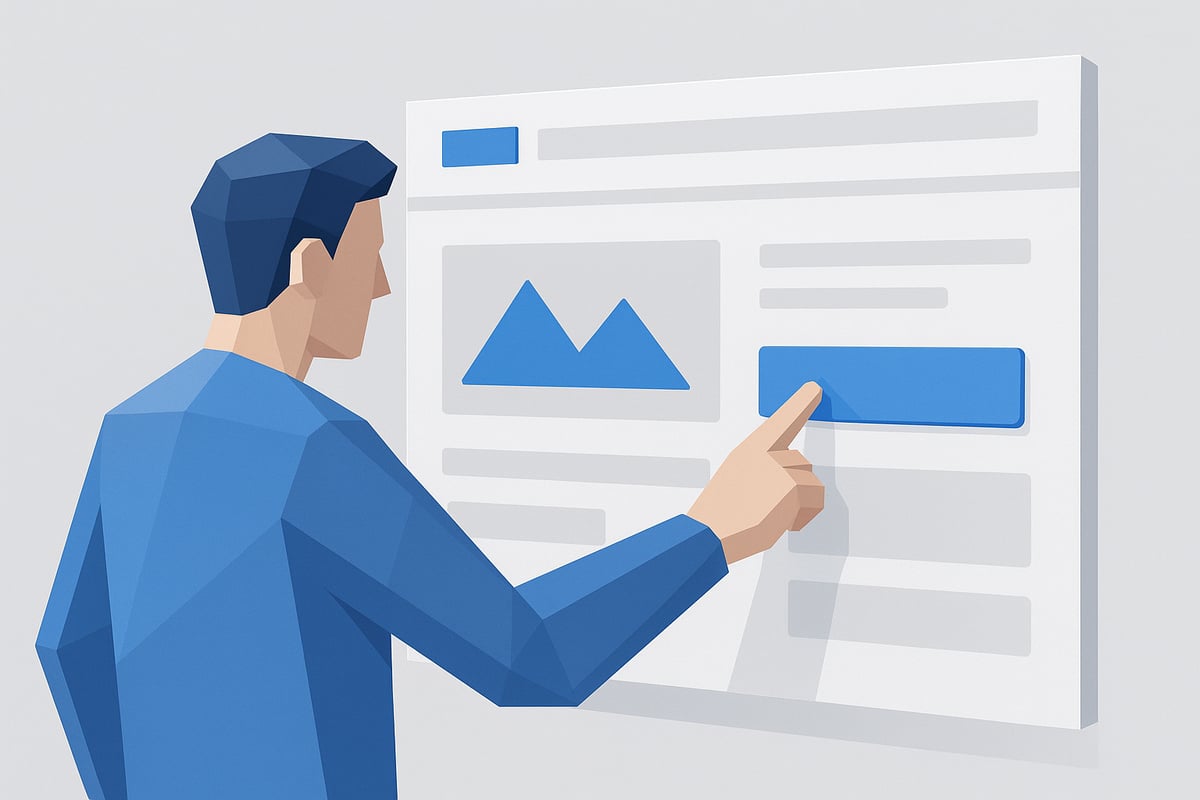Web design content is evolving faster than ever, driven by new technologies and changing user habits. As we look towards 2025, digital audiences will expect more personalised and engaging experiences from every site they visit.
Businesses that understand these shifts and apply expert insights can stand out in an increasingly crowded online world. That’s why this guide covers everything you need to future-proof your web design content—from smart planning and UX writing, to multimedia, accessibility, AI, and the latest trends.
Join us as we explore how to create content that keeps your website ahead of the curve.
Strategic Content Planning for Web Design in 2025
Building a robust strategy for web design content in 2025 means putting people first, embracing adaptability, and fostering collaboration. With digital trends shifting quickly, future-focused planning is essential for engaging your audience and staying ahead.

Understanding Audience Behaviour and Needs
Knowing who your visitors are is the heart of effective web design content. User personas help us get a clear picture of what people want, which shapes every decision we make.
Research shows over 70% of users expect personalised web experiences. For example, leading eCommerce brands use analytics to deliver content that matches shoppers' interests in real time.
Gen Z is now a driving force, with habits shaped by mobile-first browsing and instant gratification. By tuning in to their preferences, we can create web design content that feels both relevant and engaging.
Developing a Future-Proof Content Strategy
A future-proof approach to web design content means planning for change. Content should be scalable, easy to update, and flexible enough to keep pace with new technologies or branding shifts.
Agile workflows make a huge difference compared to traditional methods. They let teams respond quickly to emerging trends, ensuring content never feels stale. For foundational strategies that support adaptability, see these Web design best practices.
By building a living strategy, we can keep our web design content fresh, effective, and ready for whatever comes next.
Content Mapping and Information Architecture
Content mapping is the secret to seamless navigation. By organising web design content logically, we make it easy for users to find what they need, fast.
Successful brands often share case studies showing how intuitive structures boost satisfaction and engagement. The key is balancing SEO needs with a user-friendly experience, so nobody feels lost or overwhelmed.
A well-planned information architecture helps both people and search engines understand the value of your web design content at every touchpoint.
Integrating SEO from the Outset
SEO is no longer an afterthought for web design content. Early keyword research, especially around voice and semantic search, ensures your site is discoverable in 2025 and beyond.
Did you know 55% of website traffic comes from organic search? Integrating SEO from the start saves time and lifts your rankings, making your content work harder for you.
By weaving SEO into your planning, your web design content stands out to both users and search engines right from launch.
Collaboration Between Designers, Developers, and Content Creators
Great web design content is a team effort. Cross-functional collaboration brings together designers, developers, and writers, each adding their expertise to create something truly special.
Projects thrive when teams communicate clearly from the start. Using shared planning tools and regular check-ins, we can avoid misunderstandings and deliver stronger outcomes.
When everyone works together, web design content becomes more consistent, creative, and impactful for your audience.
Optimising UX Writing for Engagement and Conversion
User experience (UX) writing is at the heart of effective web design content. It shapes the way visitors interact with your site, guiding them smoothly from the first click to the final conversion. In 2025, expectations are higher than ever, and well-crafted words can be the difference between a lost visitor and a loyal customer.

Principles of Effective UX Writing
UX writing is all about creating text that guides users through digital journeys with clarity and empathy. Every word in your web design content should serve a purpose, whether it’s helping users find information or nudging them towards action.
Clear microcopy—think button labels, error messages, and tooltips—builds trust and confidence. For example, a simple change in button text helped one SaaS platform boost sign-ups by 30 percent. The right words can remove doubt, encourage clicks, and create a welcoming atmosphere.
Key principles include:
Clarity over cleverness
Direct, friendly language
Focusing on user needs, not just features
By embedding these principles into your web design content, you’ll help users achieve their goals and keep them coming back.
Crafting Clear and Actionable CTAs
Call-to-action (CTA) elements are the linchpin of any successful web design content strategy. Placing CTAs where users naturally pause, and using concise, actionable language, can significantly increase engagement.
Studies show that short, direct CTAs can boost click-through rates by up to 25 percent. For instance, replacing vague phrases like “Learn More” with “Get My Free Guide” provides clarity and incentive. Want more inspiration? See how ecommerce web design and development teams use tailored CTAs to drive conversions.
Best practices for CTAs:
Use verbs that prompt action
Keep the message brief
Place CTAs in visible, logical spots
With these tips, your web design content will naturally lead users towards meaningful engagement.
Tone, Voice, and Brand Consistency
Consistency in tone and voice is crucial for building trust and recognition in your web design content. Whether users are browsing product pages or reading support articles, a unified voice reassures them and reflects your brand’s personality.
For example, a playful, approachable tone on landing pages should carry through to confirmation emails and FAQs. This seamless experience makes users feel valued and understood.
To maintain consistency:
Develop a style guide for your brand’s language
Regularly review content for tone alignment
Train all content creators on brand voice
When your web design content speaks with one clear voice, you create a memorable and cohesive experience for every visitor.
Adapting UX Copy for Accessibility and Inclusivity
Accessibility is a cornerstone of modern web design content. Using plain language and inclusive messaging ensures everyone can access and understand your site, regardless of ability.
Follow the latest accessibility standards, like WCAG 2.2, to make your content readable and navigable for all. This means using descriptive headings, alt text for images, and clear link labels. Embracing inclusivity also involves reflecting diverse perspectives and avoiding jargon that might exclude some users.
By prioritising accessibility, your web design content not only meets legal requirements but also welcomes a broader audience, making every visitor feel at home.
Leveraging Multimedia and Interactive Content
In 2025, multimedia is at the heart of engaging web design content. Users expect more than just words on a page—they want vivid visuals, immersive videos, and interactive experiences that keep them exploring. Incorporating these elements transforms how audiences connect with your brand and message.

The Role of Visual Content in Modern Web Design
Visuals are more than decoration—they are essential to web design content. Industry studies show that pages featuring images and videos retain users 88 percent longer, highlighting the power of multimedia. Before and after redesigns often reveal how adding quality visuals increases engagement and keeps users browsing for longer periods.
Modern brands are embracing trends like AI-generated imagery and sophisticated scroll animations to create memorable experiences. For a deeper dive into these innovations, explore the Web Design Trends 2025 article, which offers inspiring examples of how multimedia is evolving. If you want your web design content to stand out, investing in strong visual storytelling is a must.
Interactive Elements That Drive Engagement
Interactive elements bring web design content to life. Tools like quizzes, calculators, and infographics invite users to participate, making the experience personal and memorable. For example, SaaS websites use interactive demos to boost trial sign-ups and help users understand product value quickly.
These features do more than entertain—they foster a sense of connection and community. When visitors feel involved, they are more likely to stay, share, and return. Consider how your web design content can encourage active participation, not just passive reading.
Optimising Multimedia for Performance and SEO
Optimising multimedia is crucial for both user experience and search rankings in web design content. Fast-loading images and videos reduce bounce rates and keep visitors happy. Use image compression, descriptive alt text, and video transcripts to ensure your content is accessible and discoverable.
Best practices include choosing the right file formats, lazy loading media, and providing clear captions. These steps improve your web design content's visibility in search engines and make your site inclusive for all users.
Balancing Aesthetics with Usability
Striking the right balance between eye-catching visuals and usability is vital for effective web design content. While beautiful graphics draw attention, overly complex layouts can confuse users and hinder navigation. The best sites combine rich media with straightforward menus, readable text, and accessible colour schemes.
Look for inspiration in brands that achieve clarity without sacrificing style. Remember, your web design content should guide users effortlessly, ensuring everyone enjoys the journey from start to finish.
Ensuring Accessibility and Compliance in Web Content
Creating truly inclusive web design content is not just a best practice, it is essential for reaching every user. As we move towards 2025, accessibility and compliance will set the standard for digital trust and user satisfaction. Let’s explore how your web design content can meet and exceed these evolving expectations.

Understanding Accessibility Standards for 2025
Staying up-to-date with accessibility standards is vital for effective web design content. The latest WCAG 2.2 Overview brings new guidelines that focus on enhanced navigation, cognitive accessibility, and mobile usability. These updates ensure your site welcomes all users, including those with disabilities.
Did you know that 20% of users in the UK have a disability affecting how they interact with online content? By aligning web design content with these standards, you make your website more welcoming and effective for everyone. Adopting these practices early can help future-proof your site and build trust within your audience.
Practical Steps for Accessible Content Creation
Making web design content accessible starts with the basics. Use clear headings to structure your information and help screen readers navigate with ease. Always include descriptive alt text for images, ensuring visually impaired users understand your media. Descriptive links, like 'Read our accessibility policy' instead of 'Click here', are vital for clarity.
Retail sites that improved their accessibility scores have also seen boosts in sales and customer loyalty. Simple changes, such as increasing colour contrast or using larger, readable fonts, can make a significant difference. Remember, accessible web design content benefits every visitor, not just those with disabilities.
Testing and Auditing for Compliance
Regular testing keeps your web design content compliant and user-friendly. Use accessibility audit tools to check for issues like missing alt text, unclear navigation, or poor colour contrast. Automated checkers and manual testing with assistive technologies can uncover hidden barriers.
Proactive compliance is not just about avoiding legal risk, it is about expanding your reach to a wider audience. Teams that schedule routine reviews and involve users with diverse needs in testing create more robust, welcoming websites. Consistent auditing means your web design content always meets evolving standards.
Inclusive Content Beyond Legal Requirements
True inclusion in web design content goes beyond ticking boxes. Cultural sensitivity and language inclusivity help everyone feel seen and valued. Localise your site for UK and international audiences, considering different spellings, phrases, and cultural references.
Think about imagery, examples, and tone—are they relatable and respectful to all users? Brands using localisation strategies build stronger connections and trust. When your web design content is both accessible and culturally aware, you create a space where everyone belongs.
Integrating AI and Automation in Web Design Content
The use of AI and automation is transforming how we approach web design content. As businesses race to meet rising digital expectations, these tools offer smarter, faster, and more personal ways to connect with users. Let’s explore how AI is shaping the future of web design content and what it means for your brand.
AI-Powered Content Generation and Personalisation
AI-driven tools are making it easier than ever to generate web design content that feels tailored to each visitor. By analysing user data, AI can create dynamic headlines, recommend articles, or even adjust product descriptions in real-time. In fact, recent surveys show that 60% of marketers are planning to use AI for web content by 2025.
This shift allows brands to deliver more relevant experiences. By leveraging platforms that use AI for content personalisation, your site can adapt to audience needs as they evolve. For those interested in the technical side, the AI-Native Web Interaction standard is pioneering new ways for AI to interact with web pages more intuitively.
Chatbots and Conversational Interfaces
Chatbots are now a staple of effective web design content, guiding users through sites and offering instant support. Modern eCommerce platforms are using AI-powered chatbots to help visitors find products, answer questions, and complete purchases with ease.
Conversational content like this keeps users engaged and builds trust quickly. It’s not just about automation — it’s about creating a friendly, helpful experience that feels human. Integrating chatbots into web design content can boost engagement while freeing up your team for more complex tasks.
Automation for Content Updates and Management
Keeping your web design content fresh can be a challenge, especially as your business grows. That’s where automation steps in. Content management systems now offer automated scheduling, content updates, and even AI-driven audits.
By automating these routine tasks, you reduce manual workload and ensure your web design content stays consistent across every page. Automated workflows let you focus on strategy and creativity, while the system handles the repetitive parts.
Ethical Considerations in AI Content
As AI becomes more involved in web design content, it’s important to think about ethics. Transparency about AI-generated content helps build trust. Addressing issues like bias and privacy ensures your brand remains inclusive and trustworthy.
Remember, while automation enhances efficiency, it should never replace the authentic human voice that makes your web design content unique. Balance is key for a future-ready strategy.
Emerging Trends and Expert Predictions for 2025
As we look ahead to 2025, the pace of change in web design content is truly remarkable. New technologies and user behaviours are shaping how we create and deliver digital experiences. Let us explore the trends and expert predictions that will define the next era of web design content.
Voice Search and Conversational Content Design
Voice search is set to become a dominant force in web design content strategy. By 2025, half of all searches are expected to be voice-based, according to industry forecasts. This shift means content must be optimised for natural language, focusing on how people speak rather than type.
Brands are already adapting their web design content to answer spoken queries clearly and concisely. For example, FAQs and how-to guides now use conversational phrases, making it easier for voice assistants to find and share information. This approach helps users get instant answers, building trust and loyalty.
The Rise of Headless CMS and Omnichannel Content Delivery
The adoption of headless CMS platforms is transforming how web design content is managed and deployed. A headless CMS separates content from presentation, enabling brands to deliver consistent messages across websites, mobile apps, and IoT devices.
This flexibility supports omnichannel strategies, where web design content flows seamlessly between platforms. Teams can update information once and publish it everywhere, ensuring users have a unified experience no matter how they interact with the brand. As a result, content delivery becomes faster, more scalable, and future-ready.
Sustainability and Eco-Friendly Content Practices
Sustainability has become a key consideration in web design content planning. As digital carbon footprints grow, brands are looking for ways to reduce their environmental impact. One effective strategy is to optimise media files, shrinking image and video sizes without sacrificing quality.
Some web design content teams are also adopting green hosting solutions and streamlining code to minimise energy use. For example, brands that compress images and use lighter fonts contribute to faster load times and lower emissions. These small changes can make a big difference for users and the planet.
Expert Insights: What Leading Designers Predict
Top UK web designers agree that personalisation, automation, and inclusivity will drive the next wave of web design content innovation. They predict that AI-powered tools will help tailor content to individual needs, while accessibility will remain at the forefront.
Designers also highlight the growing importance of collaboration across teams, ensuring that web design content stays relevant and user-focused. As technology evolves, staying agile and open to new ideas will be essential for success in 2025 and beyond.
We’ve covered a lot together—from planning future ready content and nailing UX writing, to embracing multimedia, accessibility, and the exciting role of AI in web design. If you’re inspired to put these expert insights into action and take your website to the next level, you don’t have to do it alone. At Futur Media, we’re passionate about turning creative ideas into digital experiences that truly stand out. Let’s work together to make your 2025 vision a reality. Ready to get started Start Project

 Written by
Written by